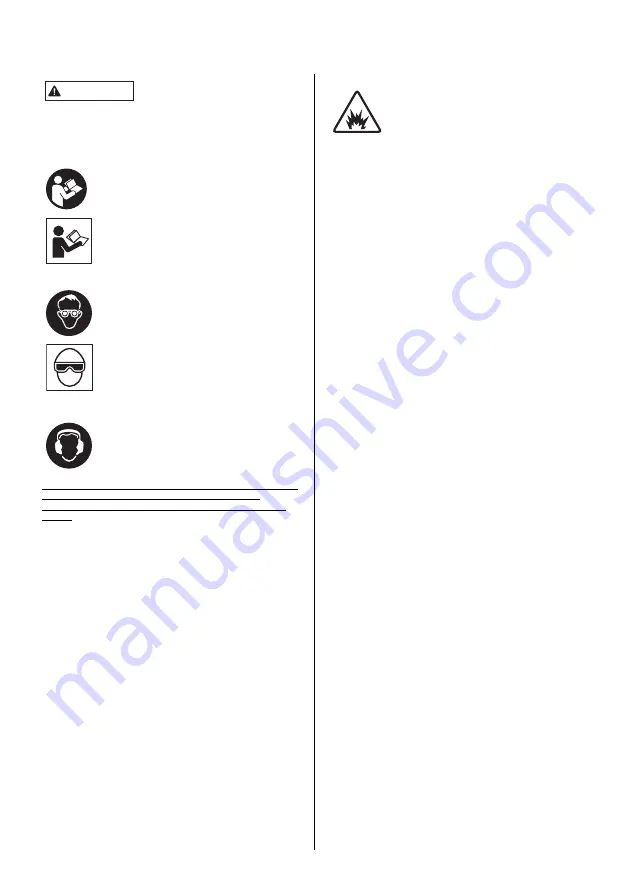
1
ENGLISH
Before using the tool, read and understand fol-
lowing instructions. Failure to so could result in
DEATH or SERIOUS INJURY.
Explanations of symbols marked on the tool.
Before using the tool, read and understand tool
labels, Safety instructions manual and Operating
instructions manual. Failure to follow warnings
could result in serious injury.
Keep these instructions with the tool for future ref-
erence.
Additional copies of this manual, operating in-
structions manual and tool labels are available
online. For further information, contact us at our
web page.
Operators and others in work area shall wear
impact-resistant eye protection with side shields.
Danger to the eyes always exists due to the pos-
sibility of dust being blown up by the exhausted
air or of a fastener flying up due to the improper
handling of the tool.
Eye protection equipment must conform to the re-
quirements of the American National Standards
Institute, ANSI Z87.1 (Council Directive 89/686/
EEC of 21 DEC. 1989).
The employer is responsible to enforce the use of
eye protection equipment by the tool operator and
all other personnel in the work area.
As the working condition may include exposure to
high noise levels which can lead to hearing dam-
age, the employer and user should ensure that
any necessary hearing protection is provided and
used by the operator and others in the work area.
EMPLOYERS, TOOL OWNERS AND TOOL OPERATORS ARE
RESPONSIBLE FOR THE SAFE USE OF THIS TOOL
AND COMPLIANCE WITH ALL WARNINGS AND INSTRUC-
TIONS.
At a Minimum, Employers, Tool Owners and
Tool Operators Must:
1. ensure that the manufacturer’s tool operating/safety instruc-
tions, warnings and labels are available to all tool operators
and users. Do not use tool with missing or damaged safety
warning label(s.);
2. select an appropriate tool actuation (trigger) system from the
options available, taking into consideration the work applica-
tions for which the tool is being used. Contact Celo authorized
distributors for information on actuation systems options;
3. train tool operators and users in the safe use of the tool as de-
scribed in the tool operating/safety instructions, warnings and
labels;
4. allow only persons who have read and understood the tool op-
erating/safety instructions, warning and labels to operate the
tool.
5. allow tool use only when tool operator and all other personnel
in work area are wearing appropriate eye protection equip-
ment, and when required, other appropriate personal protec-
tive equipment, such as, head, hearing and foot protection
equipment. Provide information about the safe duration of use
and appropriate working positions.
AVOID EXPLOSION HAZARD
1
Only use approved power source. Never use reactive high
pressure or combustible gases (e.g., oxygen, carbon diox-
ide, acetylene, flammable gases etc.) as a power source.
2
Do not operate the tool in explosive atmospheres, such as
in the presence of flammable liquids, gases or combustible
dust.
General safety rules
1
Keep fingers away from trigger when not operating this tool
and when moving from one operating position to another.
2
Keep all body parts such as hands and legs etc. away from
firing direction and ensure fastener cannot penetrate work-
piece into parts of the body.
3
Read and understand the safety instructions before con-
necting, disconnecting, loading, operating, maintaining,
changing accessories on, or working near the tool. Failure
to do so can result in serious bodily injury.
4
Place the nail discharge outlet of the tool on the work sur-
face properly when operating. Failure to place the dis-
charge outlet in a proper manner can result in fasteners
shooting away from the work surface and is extremely dan-
gerous.
5
Hold the tool with a firm grasp and be prepared to manage
recoil.
6
Only technically skilled operators should use tool.
7
Do not modify tool. Modifications may reduce the effective-
ness of safety measures and increase the risks to the oper-
ator and/or bystander.
8
When operating a tool intended to be used on hard surfaces
such as steel and concrete, put additional down force re-
quired to operate the tool and prevent slipping.
9
Do not use a tool if the tool has been damaged or is not in
proper working order. Tag and physically segregate tool to
prevent use.
0
Be careful when handling fasteners, especially when load-
ing and unloading, as the fasteners have sharp points which
could cause injury.
a
Always check the tool before use for broken, misconnected
or worn parts.
b
Do not overreach. Only use in a safe working place. Keep
proper footing and balance at all times.
c
Keep bystanders and children away (when working in an
area where there is a likelihood of through traffic of people).
Clearly mark off your operating area.
d
Never point the tool at yourself or others. Serious accidents
may be caused when misfiring. Be sure the discharge outlet
is not pointed toward people when connecting and discon-
necting the hose, loading and unloading the fasteners or
similar operations.
e
Do not rest your finger on the trigger when picking up the
tool, moving between operating areas and positions or
walking, as resting finger on trigger can lead to inadvertent
operation.
f
Only wear gloves that provide adequate feel and safe con-
trol of triggers and any adjusting devices.
g
When not in use, disconnect tool from power supply, re-
move fasteners and lay it on its side in a safe location.
h
Always refer to tool maintenance instructions for detailed in-
formation on proper maintenance of the tool. Only qualified
personnel shall repair the tool using parts supplied or rec-
ommended by Celo or parts that perform equivalently.
WARNING





































